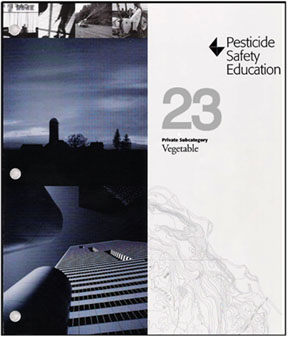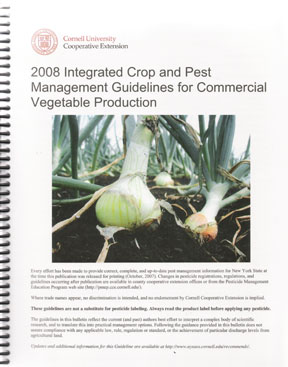PESTICIDE LABELS
INTRODUCTION
Pesticides are toxic products that are intended to prevent,
destroy, repel, or mitigate pests (such as insects, plant diseases, and noxious
weeds), or are used as a plant growth regulators, defoliants, or desiccants.
Pesticides are regulated in the United States by the Environmental Protection
Agency (EPA), primarily through two federal statutes: the Federal Insecticide,
Fungicide, and Rodenticide Act (FIFRA) and the Federal Food, Drug, and Cosmetic
Act (FFDCA). Pesticide products must be initially registered by the EPA and then
by individual states prior to distribution, sale, or use. A label, developed by
a pesticide manufacturer/registrant and approved by the EPA, is required to be
placed on all pesticide containers prior to the distribution, sale, or use of
the product by the public.
A pesticide label can mean different things to different people. To a
manufacturer/registrant, a label is a "license" for product distribution, sale,
and use; to an enforcement official, a label represents the legal sale, use, and
disposal of a product. A label provides the user with directions for correct and
legal use to control a pest problem and, finally, the label provides valuable
information to a physician in case of a pesticide poisoning accident.
LABEL VS. LABELING
The term "label" means the written, printed, or graphic matter
on, or attached to, the pesticide product or device or any of its containers or
wrappers.[1] The term "labeling" means:
-
All labels and all other written, printed, or graphic matter
accompanying the pesticide product or device at any time.
-
Reference made on the label or in literature accompanying the
pesticide or device an exception to this would be where reference is made in
official publications by the EPA, U.S. Department of Agriculture (USDA),
colleges, universities, state experiment stations, or agencies authorized by law
to conduct pesticide research
- Material Safety Data Sheets (MSDS) that come under the authority of the Occupational Safety and Health Administration (OSHA) and are not reviewed by EPA for the most part they are not considered as pesticide labeling. However, in certain cases, such as when an MSDS is intentionally distributed with a pesticide product, it then becomes part of the labeling.[1]
LABEL DEVELOPMENT
The FIFRA requires that the registrants test each active
ingredient per data requirements found in 40 CFR, Part 158 of the Code of
Federal Regulations (CFR).[2] Label requirements are also located in the CFR at
40 CFR, Part 156. The label is the culmination of the pesticide active
ingredient testing process that may take as long as 8-10 years and costs as much
as US35-50 million. [3]
Fig. 1 is an example of a typical pesticide label (numbers in parenthesis below
and in Fig. 1 refer to those items listed in 40 CFR, Part 156 that are required
to be on all labels). Every pesticide product offered for sale, distribution, or
use to the public must bear a label containing the following:
(1) The type of pesticide, (i.e. insecticide, fungicide, herbicide, etc.).
(2) The name, brand, or trademark under which the product is sold.
(3) The name and address of the producer or manufacturer/registrant.
(4) The net contents.
(5) The product registration number (EPA Registration Number). This is a unique number found on all pesticide product labels that distinguishes a pesticide from a nonpesticide product. The EPA Registration Number indicates which company holds the registration for the product and in which sequence the product was registered.
(6) The producing establishment registration number (EPA Establishment Number). This number is an indication of where the product was formulated.
(7)An ingredient statement. Each active ingredient and their
respective amount (percent) must be listed onthe label or supplemental label;
inert ingredients are not listed separately, but a total percent is listed for
all inert ingredients included in the formulation.
(8) Signal word and symbol (if required) that convey the pesticide product's
relative toxicity. A product label may display a DANGER/POISON, WARNING, or
CAUTION signal word; a skull-and-crossbones symbol is required in association
with a DANGER signal word if the ingredients are highly toxic orally, dermally,
or through inhalation.
(9) Warning or precautionary statements such as those related to worker protection standards, wearing of protective clothing during mixing and application, preharvest intervals (PHIs), restricted reentry intervals (REIs), hazards to wildlife, and environmental statements.
(10) "First Aid" statement (formerly "Statement of Practical Treatment") for poisonings and spills, which usually includes a phone number for contacting appropriate officials in case of emergencies.
(11) Directions for use including application information (rates, compatibility, etc.), sites, and pests.
(12) Storage and disposal statement.
In addition, pesticide products are classified as either "restricted -use" or "general use." All pesticide products that are restricted by EPA must have a "restricted-use" statement on their label. Applicators using "restricted-use" pesticides must be certified or work under the supervision of a certified applicator, as these products are usually more toxic to humans and/or the environment than those that are classified as "general use."

TYPES OF LABELS/LABELING
Pesticide labels are associated with the type of product
registration being issued by EPA and/or the individual states. The three most
common types of pesticide labels that the public will encounter are the Primary
Label found on the basic product registered by EPA, the Supplemental Distributor
Label, and the Special Local Need (SLN) label.
Primary Label
This label appears on the container of the registrant's basic product that has
received an approved EPA registration. The primary label will contain most, if
not all, of the registered uses that EPA has approved for a specific product
formulation with a specific, two-part EPA Registration Number (i.e., 123-456).
It should be noted here that when EPA registers a basic product, it usually
registers a technical product before or at the same time. The technical product
is used in the manufacture of the basic product and the end-use products
intended for the public.
Supplemental Distributor Label
A second company can distribute another registrant's basic product upon mutual
agreement of both parties. A three-part EPA Registration Number (i.e.,
123-456-789) on the container label will identify the product as such; the last
set of numbers identifies the company distributing the product. It is the basic
registrant's responsibility to make sure that the supplemental label is in
compliance with the basic product's label. Distributor labels usually target a
specific market and seldom contain all the registered uses found on the basic
product label.
SLN-24(c)
Section 24(c) of FIFRA allows individual states to register additional uses of
federally registered pesticides to meet an "SLN." The SLN label provides the
applicator with the proper instructions relative to the special pest problem and
contains all restrictions, precautions, and limitations found on the basic
product label. Food tolerance or exemption from the requirement of a food
tolerance is required for all pesticide active ingredients contained in the SLN
product if the use is intended to be on a food or feed commodity. For more
information, see the Pesticide Management Education Program (PMEP) website at:
http://pmep.cce.cornell.edu/regulation/index.html/.
Experimental Use Permit Label
Experimental Use Permits (EUP) are issued for field trials (greater than ten
acres terrestrial; one acre aquatic) for unregistered pesticides or registered
pesticides where a particular registration is being sought. The EUP label
follows the standard format, except that the label must include the EPA
Experimental Use Permit Number and the statements: "Not for sale to any person
other than a participant or cooperator of the EPA approved Experimental Use
program", and "For Experimental Use Only." For more information, see the
Pesticide Management Education Program (PMEP) website at:
http://pmep.cce.cornell.edu/regulation/index.html/.
VIEWING LABELS FROM THE PESTICIDE MANAGEMENT EDUCATION PROGRAM (PMEP) WEBSITE
The 1996 Pesticide Reporting Law (PRL) mandated that the New York State Department of Environmental Conservation (Department) and Cornell University work together to develop a pesticide sales and use reporting database. Commercial applicators and businesses applying and selling pesticides respectively are required to report their pesticide use and sales each year to the Department. The processed data are utilized by the Department, the New York State Department of Health, Cornell researchers, and others for further studies.
An offshoot of the pesticide sales and use reporting database has been the enhancement of an existing database that tracks pesticide product registrations in New York State. The Product, Ingredient, and Manufacturer System (PIMS) located at http://pmep.cce.cornell.edu/pims/ provides access to information relative to those products registered in New York, including label images. Label images are now accessible for those products registered (or previously registered) in New York and access is also available to primary labels registered by the Environmental Protection Agency (EPA).
To view label images from PIMS and from EPA, the user will need to use a multiple page tif viewer. If you are using a PC with a Microsoft Windows platform, you already have the necessary viewer (Imaging, Wang Imaging, or Windows Picture and Fax viewer) installed. If you are using the Macintosh platform with earlier versions than OSX, you will need to obtain a viewer program. For Macintosh computers running operating system (OS)8 or (OS)9, we recommend a program from Lemke Software, (http://www.lemkesoft.com/us_index.html), called "Graphic Converter" (USD $35). Macintosh computers running (OS)X have a program called "Preview" already installed that will display multiple tif pages.
For more information regarding pesticide information, please log onto our program website at http://pmep.cce.cornell.edu/.
Label Viewing Recommendations
In order to view NYS labels on our web site you must be using Internet Explorer, (5.5 or 6.0), or Netscape, (4.7 through 6.0). We do not support viewing the labels with Netscape 7.x, (tested and found to be flawed), nor will we support other newer version of these browsers until they are added to the list on this page.
If you are already using an approved version of one of these browsers and find that you cannot view the labels, or can only view the first page, please download and install one of the excellent viewer plugins that we recommend, (Alternatiff for the PC or Graphic Converter on the Mac).
If you are a PC user you can also download the .tif files to your computer and then view them by doing the following:
1) Click with the right mouse button and choose "Save file as" from the menu that pops up, then save the tif file to your desktop.2) After saving the file to your desktop, hold down the shift key and right click on the file name and choose "Open With" from the menu that pops up.
3) From the list of programs that appears choose "Imaging", and select the check box at the bottom that says "Always use this program to open these files", then click "OK".
4) The file will open and you will be able to view all the pages.
If you are a Mac user, you can download the files, but really need the Graphic Converter program to make it work, (unless you are running OSX).
Setting up Graphic Converter on the Mac, (OS 8.6 or 9.x), using Internet Explorer 5.1
Obtain and install Graphic Converter from Lemke Software:
http://www.lemkesoft.com/
If after installing the Graphic Converter software you find you can only see the first page of a label, you must make some configuration changes in IE.
1) Open IE and click on Edit, then Preferences.
2) Look under the "Receiving Files" category for the entry named "File Helpers".
3) Use the scroll bar on the left hand side of this box to scroll down to "Tiff
Picture", (there may be several entries, you must be sure to change all of
them).
4) Click on "Tiff Picture", then the change button.
5) Under "File Type", use the Browse button to find and select "Graphic
Converter", (use Sherlock if you are not sure where you installed it).
6) In the same dialog box, go to "Handling", click on the drop down menu and
choose, "Post Process with Application".
7) If the application is not already set to Graphic Converter, then use the
browse button and set it to Graphic Converter.
You should now be able to view all pages of the NYS labels.
Links to Label Viewers:
Mac - http://www.lemkesoft.com/
PC - http://www.alternatiff.com/
Quicktime Problem - PC and MAC
If you have followed all the instructions and recommendations and are still having a problem, you may be experiencing the "QuickTime Problem". Apple has changed the QuickTime installation program so that takes over many system settings. If you have installed "QuickTime" in its default configuration, your computer may ignore other plugging and file associations that you have set up.
The key to fixing this problem:
1) Start the QuickTime player and go to
Edit/Preferences/QuickTime Preferences.
2) Click on MIME Settings.
3) Click on the plus sign next to "Images".
4) Uncheck the box next to "TIFF Image file".
5) Click OK, then close the "QuickTime Settings" dialog box too, unless you are
a PC user, in which case you should follow steps 6 and 7.
6) IF you are a PC user, you should also click on the "down arrow" in the
"QuickTime Settings" dialog box and go to "File Type Associations".
7) Uncheck all the boxes, then exit by clicking the "X" in the upper right
corner of the box.
At this point QuickTime will no longer prevent your other software from working
properly, and you should be able to view labels, provided you have followed our
recommendations.
LABEL INITIATIVES
The United States and other countries have been working for over
a decade to develop a Globally Harmonized System of Classification and Labeling
of Chemicals (GHS). The GHS is designed to provide a common and coherent
approach to defining and classifying hazards, and communicating information on
labels and safety data sheets. Benefits of harmonization include enhanced
protection of human health and the environment, more consistency in the
classification and labeling of all chemicals, and enhancement of safer
transportation, handling, and use of chemicals in transport and the workplace.
The GHS is now complete and was adopted by a United Nations Committee in
December 2002.[4]
The EPA initiated a Consumer Labeling Initiative (CLI) in conjunction with other
stakeholders in March 1996. The purpose of the CLI is to make pesticide labels
easier to read and understand, especially for those using indoor insecticides,
outdoor pesticides, and household hard surface cleaners.[5] Several
recommendations have been made via this initiative and some changes have already
been incorporated on recent labels.
CONCLUSION
Pesticides are one of several tools that private and commercial applicators, food producers, and health officials have available to them for managing pest problems. In the absence of nonchemical control practices, pesticides may be the only option for a particular pest problem. Pesticide labels and related labeling provide the user with the necessary legal information for proper pest control, mixing, application, and use instructions. They also provide precautionary statements related to the environment, as well as other restrictions and limitations. In addition, individual states can require that further restrictions be placed on the EPA-registered label prior to registration in that state, especially where there are groundwater and surface water concerns. The information on the label comes from extensive research and testing by the manufacturer/registrant and a thorough review by EPA. Notwithstanding, it is a violation of federal and state statutes when applicators use a pesticide product inconsistent with the container label and related labeling.
REFERENCES
1. U.S. Environmental Protection Agency. Label Review Manual;
Office of Pesticide Programs; U.S. Environmental Protection Agency: Washington,
DC, 1995; 1-97.
2. Office of the Federal Register, National Archives, and Records
Administration. Code of Federal Regulations, 40 CFR Parts 150-189; U.S.
Government Printing Office: Washington, DC, 2002; 1-723.
3. What's Behind a Pesticide Label? The Pesticide Label Is Your Safety
Check; Responsible Industry for a Sound Environment (RISE): Washington, DC.
http://www.pestfacts. org/behind-label.html (accessed July 2003).
4. Pont, R. In Global Harmonization of Hazard Labeling and Impacts,
Proceedings of the North American Pesticide Applicator Certification and Safety
Workshop, Honolulu, HI, August 11-14, 2003; U.S. Environmental Protection
Agency: Washington, DC, 2003.
5. U.S. Environmental Protection Agency. Consumer Label-ing Initiative,
Federal Register 61 FR; U.S. Government Printing Office: Washington, DC, 1996;
12012-12013.
Prepared by: William Smith, Pesticide Management Education Program, Cornell University, Ithaca, New York
Federal Register Vol. 69, No. 164, 8/25/04 - Pesticides; Implementation of Globally Harmonized System (PDF)
Globally Harmonized System of Classification and Labeling (GHS) (PowerPoint Presentation)
Cornell University is committed to making our websites accessible to everyone, including individuals with disabilities. To report a problem or to request an accommodation to access online materials, information, resources and/or services, please contact web-accessibility@cornell.edu. In your message, include the website address or URL and the specific problems you have encountered. You will receive a reply as soon as possible.





